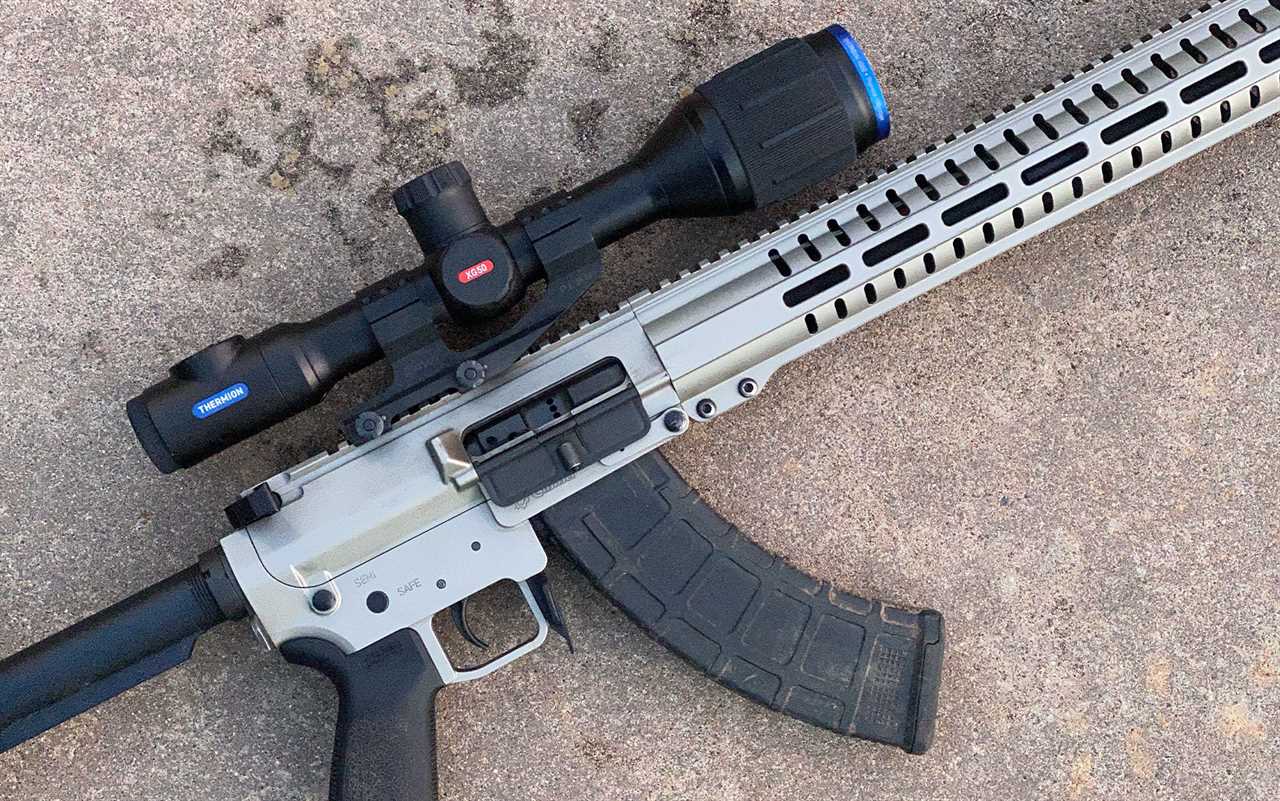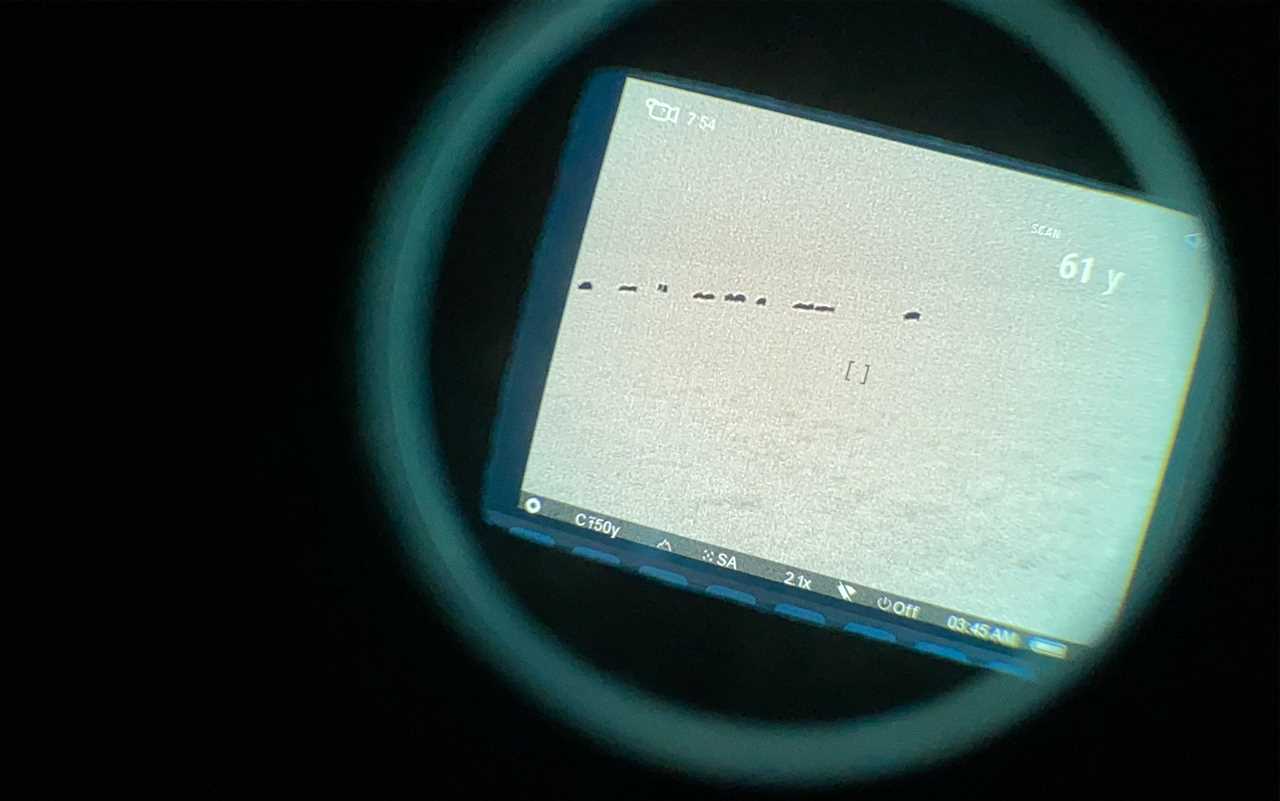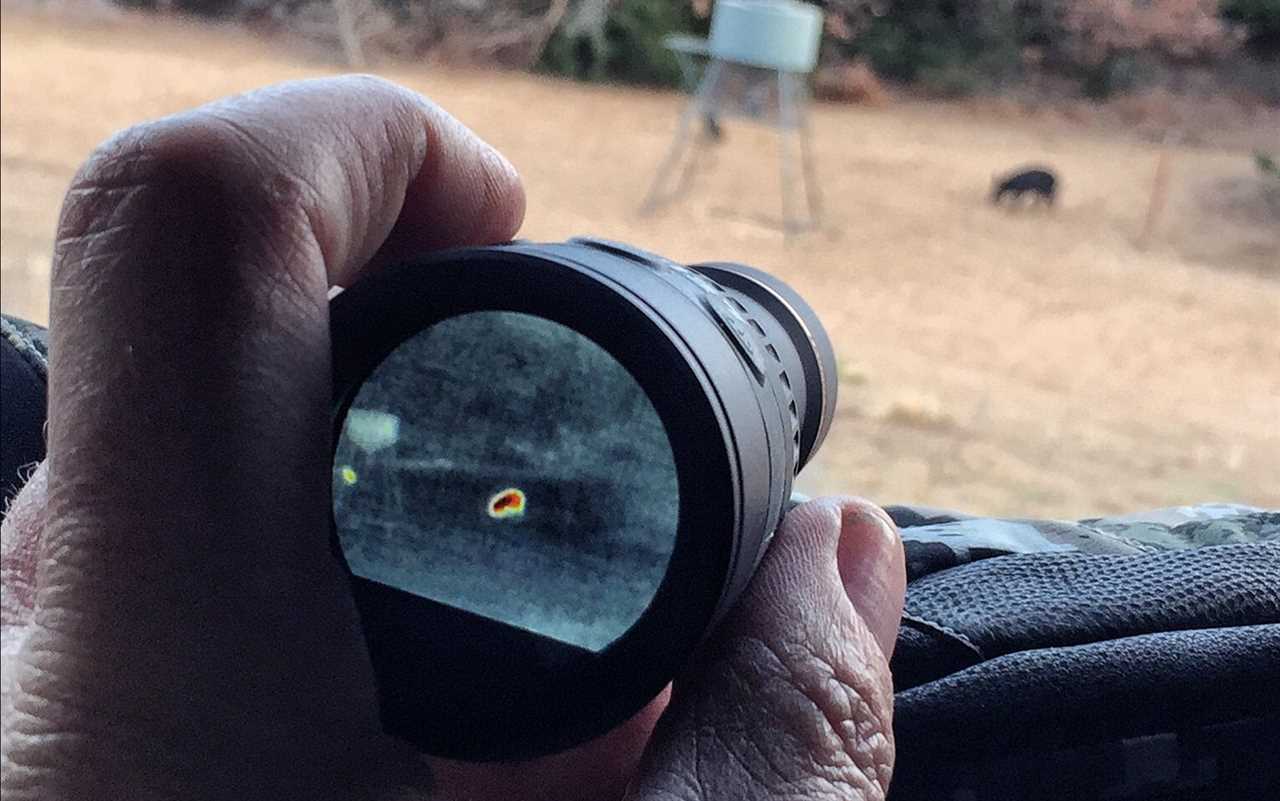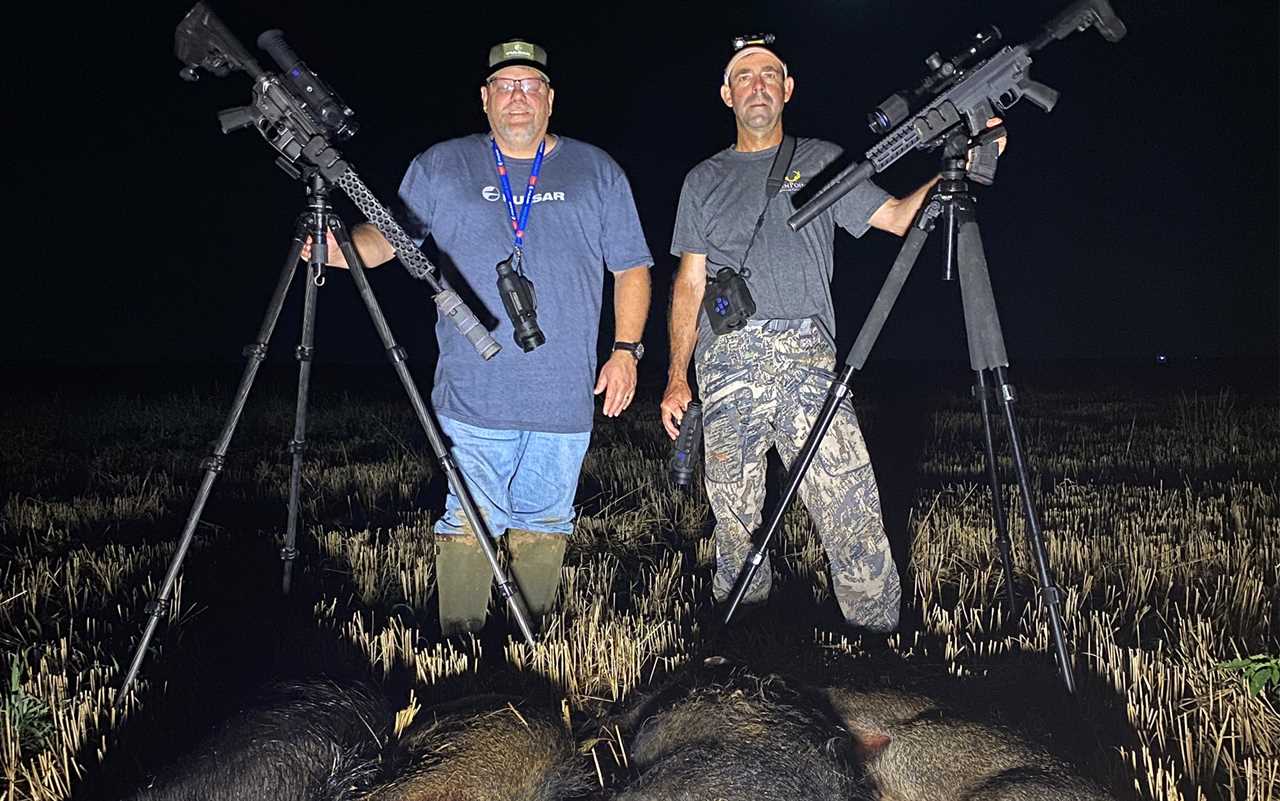We may earn revenue from the products available on this page and participate in affiliate programs. Learn More ›
Thermal scopes don’t just level the playing field; they tip the field decidedly in favor of users because they cheat nature by allowing us to see through the dark. The advantage they give hunters is the main reason they’re prohibited for most game hunting. But for unregulated non-game animals, like coyotes and feral hogs in many states, they’re an unequaled aid. They have plenty of other uses, from finding your child in the dark to detecting electrical shorts inside walls.
It’s a category in the process of rapid evolution. New models have on-board rangefinders, high-definition video and still photo capability, and even Bluetooth connections to mobile apps. Even better, the price for many of these units has fallen to a level where they’re affordable for nearly every budget. So which thermal is for you? Read on for reviews of the best thermal scopes available.
- Best Handheld: Zeiss DTI 3/35
- Most Durable: Trijicon IR-Hunter 35mm
- Best Reflex Sight: X-Vision Thermal Reflex Sight Wide View
- Best Budget: Sightmark Wraith 4k Mini
- Best Rangefinding Scope: Pulsar Thermion 2 LRF XP50 PRO
- Best Clip-On: Leica Calonox
- Best for $1,000: Liemke Keiler-13 PRO
- Best for ARs: Burris BTS50 Thermal Riflescope
Best Handheld: Zeiss DTI 3/35
Why It Made The Cut
A thermal imaging viewer and camera with decent optics and good digital resolution, the DTI’s ergonomics are the best in the field.
Key Features
- Weight: 14.5 ounces
- Height: 2.6 inches
- Display: 1.6 inches
- Magnification: 1-4-power
- Thermal Sensor Resolution: 384×288
- Display Resolution: 1280×960
- Pixel Pitch: 17 um
- Frame Rate: 50Hz
- Field of View: 57 feet at 100 yards
- Range: 1,350 yards
- 4 color palettes (white hot, black hot, red hot, rainbow)
Pros
- Picture-in-picture feature
- Hot tracking mode
- High frame rate reduces flickering
- Bluetooth connectivity with Zeiss Hunting app
- Excellent controls and ergonomics
- Good battery life
Cons
- At about $3,000, it’s pricey
- Does not mount to a rifle
Product Description
This is Zeiss’s entry into the thermal imaging realm, and it’s a good freshman effort, with very thoughtful design and decent performance. Note that Zeiss offers a companion 3/25 unit with a much wider view that’s useful in close quarters like woods and bait sites. With a 1,350-yard range, the 3/35 is better for open fields where you have longer detection ranges. Because of European prohibitions on the manufacture and marketing of devices that have military applications, rifle-mounted thermal scopes are simply not a thing there. Hence, the introduction of so many thermal viewers from European brands. The big question for American buyers is whether a hand-held viewer is as useful as a rifle-mounted thermal scope.
While an all-in-one scope is certainly a better option for many uses—hog and predator hunting, among them—I got a lot out of this Zeiss as a tracking tool, (non-game) animal spotter, and to find my pickup after an after-hours hunt got me turned around.
Most Durable: Trijicon IR-Hunter 35mm
Why It Made The Cut
This is a tank of a thermal optic, built for battle and designed for easy one-hand operation in the most stressful situations.
Key Features
- Weight: 1.8 pounds
- Height: 3.2 inches
- Display: 1.6 inches
- Magnification: 1-8-power
- Thermal Sensor Resolution: 640×480
- Pixel Pitch: 12 um
- Frame Rate: 30Hz
- Field of View: 63 feet at 100 yards
- 6 reticle options: classic, MRAD, MOA, and 3 BDC reticles
- 2 color palettes: white hot and black hot
Pros
- Made in USA
- Q-LOC mount is easy and simple
- Intuitive knobs for easy menu selection
- USB-C connector for external power
- Durable aluminum housing
Cons
- At over $7,500, expensive
- No on-board image memory
Product Description
This battle-hardened thermal scope is as durable and as simple as they come, and when operating in darkness, simplicity is a virtue. The knob-dialed menu options are fast, easy, and intuitive—no more toggling through menu screens in order to dial down intensity or change reticles. The Q-LOC mount is equally simple, and makes swapping out scopes a cinch, even in the dark. Other pluses are a high-contrast display and the ability to choose any of six different reticle options: classic crosshair, MRAD, and MOA versions, and BDC reticles for .223, .308, and 300BLK.
Unlike most of the thermal sights and viewers, this one is made in the United States, a requirement for consideration by the military and law enforcement, the hard duty where the IR-Hunter earned its stripes as one of the best thermal scopes.
Best Reflex Sight: X-Vision Thermal Reflex Sight Wide View
Why It Made The Cut
Configured for close-quarters engagements, this unit’s wide field of view is perfect for fast target acquisition and tracking after the shot.
Key Features
- Weight: .55 pounds
- Height: 3 inches
- Display: 1.6 inches
- Magnification: 1-4-power
- Pixel Size: 17 um
- Frame Rate: 25Hz
- Field of View: 250 feet at 100 yards
- 650 nm laser
- 4 color palettes (white hot, black hot, red hot, full color)
- 4 reticle choices
Pros
- Quick-release Picatinny mount
- Compatible with ARs and crossbows
- Extra-wide field of view
- 500-yard detection range
Cons
- Limited utility
- Pricey for niche product
- Tediously small controls
Product Description
A sized-down thermal sight for fairly specific uses, this is the reflex sight for night hunters. Its detection range is limited to 500 yards for vehicle-sized targets, and closer to 200 yards for pig-sized targets. But given that most shots on nocturnal pigs and predators are inside that distance, it’s a good choice for AR rifles because of its capability for fast follow-up shots. It’s also a very handy tracking tool, because at 1x the X-Vision Thermal Reflex Sight can take in a lot of ground and then assist in fast, close follow-up shots.
Best Budget: Sightmark Wraith 4k Mini
Why It Made The Cut
This is the complete package for night hunters: a fast, precise thermal scope with five rifle profiles so you can swap it between guns and it’ll save your zero. And it’s priced well under $1,000.
Key Features
- Weight: 1.35 pounds
- Height: 2.9 inches
- Magnification: 2-16-power
- Saves five rifle profiles
- Objective Lens Diameter: 32mm
- Thermal Sensor Resolution: 3840×2160
- Display Resolution: 1280×720
- IR Wavelength: 850nm
- Field of View: 40 feet at 100 yards
- 4K recording with sound
- 14 reticle options in both first- and second-plane configurations
- 9 color palettes
Pros
- On-board video recording with audio
- 14 reticle options with 9 colors
- Daytime and night-vision modes
- Durable aluminum housing
- Both first- and second-plane reticles
- USB-C external power connector
- Appealing price
Cons
- Effective range limited to 300 yards
- Sluggish operation in cold temperatures
- No on-board rangefinder
Product Description
Consider this the thermal scope for us mortals. Priced well under $1,000, the Wraith offers a wide range of features and utility for hog and predator hunting at night, but also daytime hunting and shooting. The scope, also available in a 4-32-power version, is easy to mount on a variety of platforms with a repeatable zero using the fixed Picatinny mount.
Best Rangefinding Scope: Pulsar Thermion 2 LRF XP50 PRO
Why It Made The Cut
If you’re looking for a single, do-everything thermal scope, this is your biscuit. You get the capabilities of the best rangefinders with a detection range out to 1,500 yards, in an excellent thermal scope with selectable reticles, and video imagery that can be shared via Wi-Fi. Unlike many blocky scopes, this weighs less than 2 pounds and mounts with standard 30mm scope rings.
Key Features
- Weight: 1.9 pounds
- Height: 3.15 inches
- Magnification: 2.5-10-power
- Objective Lens Diameter:
- Thermal Sensor Resolution: 384×288
- Display Resolution: 1024×768
- IR Wavelength: 17nm
- Field of View: 61 feet at 100 yards
- 4K recording with sound
- 10 reticle options
- 8 color palettes
Pros
- Mounts on standard 30mm rings
- 2,000-yard detection range
- Long battery life
- Dual battery system
- 16 GB internal memory
Cons
- Cold slows performance
- Internal operation slows when Wi-Fi deployed
Product Description

Andrew McKean

Andrew McKean
The Pulsar Thermion 2 Pro has upgraded features including a more powerful laser rangefinder.
There’s a reason most Texas hog-hunting guides run Thermions on their rifles. They’re intuitive, durable, and they work in just about any condition. And, at about $4,000, they’re affordable enough to run on multiple rifles. The new Thermion 2 Pro has a number of enhanced features from the original: a better, more powerful laser rangefinder (a must for making precise shots at distance), high-contrast display, and enhanced Wi-Fi that makes sharing videos a cinch.
Best Clip-On: Leica Calonox
Why It Made The Cut
While many thermal devices add layers of complexity, with rangefinders, multiple palettes, and a variety of reticles, the Calonox is a simple 1-power thermal that has excellent contrast and simple operation.
Key Features
- Weight: 1.9 pounds, with battery
- Height: 2.6 inches
- Display: .39 inches
- Magnification: 1-power
- Objective Lens Diameter; 42mm
- Detection Range: 2,200 yards
- Thermal Sensor Resolution: 384×288 pixels
- Display Resolution: 1024×768 pixels
- Pixel Pitch: 17 um
- Frame Rate: 50Hz
- Field of View: 50 feet at 100 yards
- High-definition black-and-white
Pros
- Suitable for viewer or sight
- High-contrast image
- Wide field of view
- Mobile app serves as remote control
- Three-button menu is simple to use
Cons
- Lack of magnification
- Lack of multiple palettes
- Relatively expensive
Product Description
This high-definition thermal sight is designed to be used in tandem with a standard rifle scope, though it works just fine as a hand-held viewer and camera. It’s if you have one of the best rifle scopes and want to use day and night. Among its assets include a very high-contrast, high-definition image, super-simple controls, and adequate video recording capability. Noteworthy is the range and sensitivity of the Colonox. It has a detection range of 2,200 yards (meaning you can tell there’s an animal out that far), a recognition range of 766 yards (it’s a deer), and an identification range of 383 yards (it’s a 10-point buck). That’s pretty handy for a hand-held viewer, but when connected to a rifle scope that provides an aiming point, this becomes a very useful device, indeed.
Best for $1,000: Liemke Keiler-13 PRO
Why It Made The Cut
Priced not much over $1,000, this hand-held viewer has great basic thermal capabilities without added features that boost the price.
Key Features
- Weight: 11.6 ounces
- Height: 6.3 inches
- Display: .39 inches
- Magnification: 2-power
- Objective Lens Diameter; 13mm
- Detection Range: 500 yards
- Thermal Sensor Resolution: 240×180 pixels
- Pixel Pitch: 17 um
- Frame Rate: 50Hz
- Field of View: 164 feet at 110 yards
- Five color/contrast modes
Pros
- Very good battery life
- Tripod mount
- Extremely light weight
- Very wide field of view
- “Hot Spot” tracking feature
Cons
- Relatively small objective lens
- Video transfer requires cable
- Hard to mount on a rifle
Product Description
Both simplicity of operation and a very appealing price—about $1,100, depending on the strength of the Euro—make this a good choice for hunters and wildlife viewers getting into thermal imaging. The Keiler-13 (it means boar in German, which gives you an idea of its customer and purpose) has intuitive controls and a surprisingly good image, given the relatively small objective lens. Video and still-image capability are both good, though you must connect a cable to the device to export images. The threaded tripod adapter is an excellent addition we wish more brands would incorporate.
Best for ARs: Burris BTS50 Thermal Riflescope
Why It Made The Cut
Built for battle, this is one of the most durable and easy-to-use thermal riflescopes on the market, and the incorporated rail makes AR mounting a cinch. Also a cinch: the one-hand, one-button control.
Key Features
- Weight: 25.4 ounces
- Height: 2.9 inches
- Magnification: 3.3-13.2-power
- Objective Lens Diameter; 50mm
- Detection Range: 2,200 yards
- Thermal Sensor Resolution: 400×300 pixels
- Display Resolution: 1024×768 pixels
- Pixel Pitch: 17 um
- Refresh Rate: 50Hz
- 7 color palettes
- 10 reticle options
Pros
- Novel single-button control
- Manual focus
- Incorporated rail mount for ARs or bolt guns
- Available in either 50 or 35mm versions
- On-board battery
- Hot-track capability
- Video and still-image recording capability
- 3-year warranty
Cons
- Cable required for image transfer
- Single-button control has learning curve
Product Description
While the market for thermal sights and scopes is growing, the supply has been dominated by off-shore brands. Burris aims to change that with this beefy, battle-ready thermal scope that can handle the rigors of the field and is right at home on an AR or chassis rifle. The unit—available in 50mm or 35mm configurations—has a genius single-button control that guides its performance. Push the button for menu selections, then turn the knob to scroll through options. The BTS50 is quick and intuitive, if it takes some getting used to. Priced around $3,000, this is a unit that is overbuilt so you can kill many coyotes over many seasons with it.
Things to Consider Before Buying a Thermal Scope or Viewer
The first thing you should consider if you’re in the market for one of the best thermal scopes is how you’ll use it. Do you want a rifle-mounted scope, with reticle and even a built-in laser rangefinder? If that’s the case, then you’re looking at a fairly expensive subset of thermals. Or maybe you just want a unit to see into the night. A hand-held thermal will do just fine, at a fraction of the cost of the thermal scopes, but without any ability to place after-hour shots.

A hand-help thermal unit might be all you need. Andrew McKean
Second, consider your budget. You can spend anywhere from about $1,000 to well over $10,000 on these devices. But if you’re simply interested in a viewer to detect animals or maybe a car parked at a trailhead, you won’t need all the bells and whistles of a scope. But if you want a plug-and-play scope to shoot coyotes or varmints after legal shooting light, then you should expect to pay well over $3,000 for the most capable rifle-mounted sights.
FAQs
Q: How much do thermal units cost?
Thermal units range in price from around $1,000 for basic thermal viewers to over $7,000 for the most sophisticated rangefinding scopes. Keep in mind that these aren’t night-vision units, which can cost only a few hundred dollars. Thermal scopes depend on a rare-earth element called germanium, which supplies temperature-sensitive glass for thermal units. Generally speaking, the best combination of attributes, capability, and overall utility of thermal units will set you back around $3,000.
Q: What do sensor and display resolution numbers really mean?
That’s a great question. You’ll generally see a couple of different resolution equations mentioned for thermal devices. One measures the sensitivity of the sensor, or the interface that receives the thermal image. The bigger the numbers, the more detail the sensor is receiving. That’s generally a function of quality components and size of the objective lens. For higher-quality units, look for sensor resolution of about 640×480 pixels. You also want to pay attention to the display sensitivity. That’s a measurement of how much detail you’ll see on the screen of the device. The higher the number, the more contrast and detail you’ll observe. Resolution of 1064×748 provides very good visibility.
Q: What’s the best brand of thermal sight?
There are a number of quality brands on the market, but generally European brands only have thermal sights or what are called clip-on units, intended to be used with a standard riflescope. Units from Russia and Southeastern Europe generally have a good combination of rangefinding riflescopes and hand-helds, though quality is variable. Then there are American brands such as Trijicon and Burris that have consumer versions of their military-grade thermals.
Q: Can I hunt with a thermal scope?
Generally, thermal scopes and viewers are illegal to use in pursuit of game animals, like deer or turkeys. But most states allow their use for non-game animals, like coyotes or raccoons. You’ll have to check with your state’s hunting regulations to see if they’re expressly prohibited. Because they occupy a gray area, it’s a good idea to also check with your local game warden.
Methodology

The author tested the best thermal scopes afield while hog hunting. Andrew McKean
I requested a number of models of thermals from a wide variety of companies. Some submitted rifle-mounted thermal scopes, others sent hand-held thermal viewers. I mounted the scopes to both AR and bolt rifles and put each submission through a field of fire, engaging nocturnal targets from 50 to 500 yards. I assessed their ease of use, ability to sight in and then engage targets at a variety of distances, and I used the full complement of reticles, palettes, and magnifications that they offer. The hand-held viewers were harder to assess, because they’re not precision aiming devices. With those units, I tested their battery life, ability to detect fine and coarse targets, and their ease of operation.
I rated each unit on 10 different criteria and took off points for confusing menus and clunky ergonomics.
Final Thoughts
The best thermal scopes and hand-held viewers are getting more affordable and accessible by the day. Until you are able to see through the darkness and pick up thermal signatures several hundred yards out in the field, you might not think you need one of these devices. But once they reveal all the hidden secrets of the night, you’ll want one just to see what happens around you in the dark.
But not all thermals are created equally. Generally speaking, you get what you pay for, with the cheaper units lacking some crucial attributes, but the most expensive having more modes and capabilities than most people normally need.
The post The Best Thermal Scopes of 2022 appeared first on Outdoor Life.
By: Andrew McKean
Title: The Best Thermal Scopes of 2022
Sourced From: www.outdoorlife.com/gear/best-thermal-scopes/
Published Date: Tue, 08 Nov 2022 22:01:13 +0000
----------------------------------------------
Did you miss our previous article...
https://manstuffnews.com/weekend-warriors/the-origin-story-of-how-deer-hunters-learned-to-rattle-in-bucks
 Backyard GrillingWeekend WarriorsAdvice from DadBeard GroomingTV Shows for Guys4x4 Off-Road CarsMens FashionSports NewsAncient Archeology World NewsPrivacy PolicyTerms And Conditions
Backyard GrillingWeekend WarriorsAdvice from DadBeard GroomingTV Shows for Guys4x4 Off-Road CarsMens FashionSports NewsAncient Archeology World NewsPrivacy PolicyTerms And Conditions
